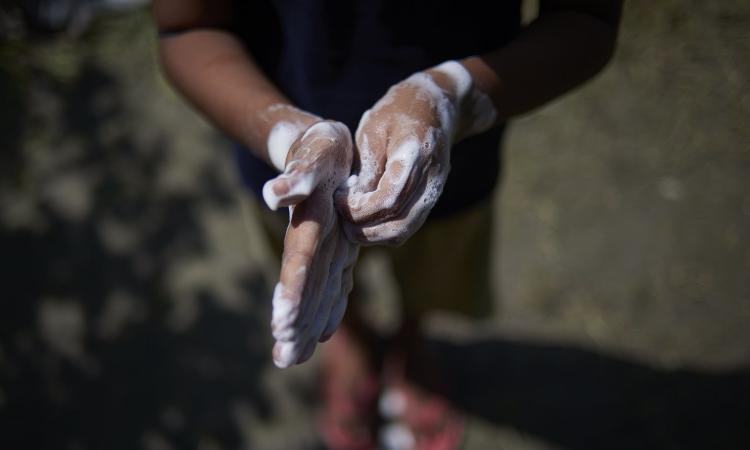
This year, Global Handwashing Day (observed annually on October 15) is particularly significant given the COVID-19 pandemic. While vaccine trials are ongoing, protective actions such as handwashing with soap is a critical first line of defence and cost-effective public health intervention. Yet this seemingly simple and hugely beneficial act of cleaning one’s hands with soap at times when germs are most likely to enter bodies is quite complex and challenging to practice consistently.
To reach out to the last mile, as soon as possible, to promote awareness and adoption of critical and preventive hygiene practices, WaterAid India (WAI) designed and implemented a communications campaign on essential hygiene messages – simple and effective messages -- for rural and urban communities.
WAI launched an eight-day intensive campaign in seven languages -- Hindi, Marathi, Kannada, Telugu, Malayalam, Odia and English -- using digital posters, audio messages and video messages on ‘good hygiene practices. We directly reached over 10 lakh individuals across 12 States.
As the lockdown as being lifted, WAI conducted a rapid study in end May-early June to understand whether communication on hand hygiene during lockdown (March – April) was received, understood, and translated into action. The study was conducted across six states in Uttar Pradesh, Bihar, Madhya Pradesh, Chhattisgarh, Odisha and Karnataka.
The majority of respondents to this study were adults from households with children under six years; elderly above 60 years of age; and households identified as vulnerable or marginalised according to the existing socio-economic criteria.
The findings have implications for interventions and policy actions for incorporating hygiene promotion into large-scale health, nutrition, and water, sanitation, hygiene (WASH) programs.
Key finds from the rapid survey are:
- Respondents changed their handwashing practices in response to the pandemic, primarily out of fear of coronavirus and to protect themselves from the disease.
- Soap was used by the vast majority to wash hands, with 80% washing hands for at least 20 seconds.
- The perceived benefits of handwashing with soap was slightly higher for coronavirus than for other diseases, though the knowledge was moderate in both contexts. The knowledge that soap is an effective cleansing agent is high.
Exposure to messages on coronavirus and handwashing was frequent; with a preference for simple, clear messages that are visual and engaging. The stark difference between the proportion reporting exposure to messages on mask use and its connection with messages on respiratory hygiene (20%) and COVID-19 symptoms (47%) suggest the link between the two may have been poorly understood by households.
Television was the most popular form of mass media communication on coronavirus (61%) and handwashing (58%), followed by mobile phone (43% for coronavirus, 45% on handwashing).
- Families received messages about coronavirus and protective measures such as mask use (76%), physical distancing (70%) and handwashing with soap (67%) during the lockdown phase of the pandemic (April-May 2020). However, only 20% recalled communication on respiratory hygiene and 47% to information on COVID-19 symptoms - suggesting that information on the link between protective measures and the transmission of coronavirus may have been inadequately communicated or poorly understood by the households.
Informal community networks and frontline workers, as well as television and mobile phones, were the main sources of information on coronavirus and handwashing. The capacity of community-based stakeholders to promote hygiene and support hygiene practices must be strengthened. Mass messaging through TV and mobile phones must be enhanced to reinforce hand hygiene habits.
- Knowledge of critical times for handwashing was high for before meals (98%) and after toilet use (87%), but low for handwashing related to child care tasks and for all COVID-19 related critical times.
- 57% of households used water directly from a handpump or stored water without a tap for handwashing – which could pose difficulties to regular handwashing by family members.
- For 18% of households, the handwashing space was outside the home – challenging frequent handwashing by household members.
While knowledge of soap use is high, clear understanding of how diseases, including COVID-19 spread, and how handwashing with soap breaks disease transmission routes appear limited. Further, the perception that handwashing protects the self, but not necessarily others in one’s family (persons in close contact) indicates an inadequate understanding of disease transmission and protective measures.
The rationale behind the survey
Studies on handwashing with soap concerning COVID-19 show that people are more aware of hand hygiene. But we cannot stop here.
We now need to turn our attention to engendering this important behaviour in the long term – supporting individuals and families with conveniently located handwashing facilities equipped with soap and water, deepening understanding of how handwashing works to protect families and communities, and building the capacity of community networks to promote and support hygiene behaviours. Our investments must continue for awareness generation, and be expended to address appropriate hygiene infrastructure and sustained behaviours.
WaterAid India is committed to hand hygiene for COVID-19 and beyond. We are launching communication campaigns for schools and anganwadis to facilitate protective hygiene practices among children, their parents, teachers and anganwadi workers.
The full study is attached below -